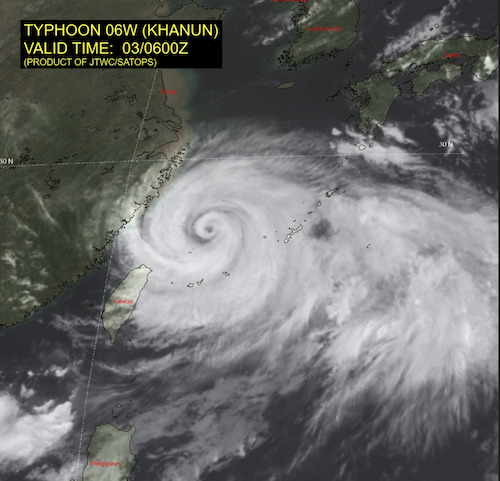Weather: Deadly Storms Lash East Asia
Typhoon Khanun, the third typhoon to hit East Asia in as many weeks, has lashed southern Japan, forcing evacuations and cutting off power to one-third of homes on the Okinawa islands.
Published 2 years ago
The slow-moving Typhoon Khanun threatens to worsen the heaviest rains in Beijing in more than a century, with the deluge causing the deaths of at least 34 people in China so far.
Khanun follows two other typhoons, Talim and Doksuri – a super storm – which also drenched the Philippines and Taiwan, killing more than 30 people, in the last few weeks.
Japan’s tropical Okinawa islands were expected to face the brunt of Khanun’s 252km/h (156mph) winds. About 20,000 people have been advised to evacuate and nearly 900 flights have been cancelled at Okinawa’s Naha airport.
This is peak tourist season for the island and such strong storms are rare at this time of the year in Japan.


Heavy rain from Typhoon Doksuri
An earlier storm – Typhoon Doksuri – made landfall in southern China in late July, with the force of a Category 2 hurricane, pushing a mass of moist air northward that led to heavy rain in Beijing and other northern cities.
On its way to China, Doksuri also had battered the northern Philippines with the force of a Category 4 storm. The Philippine authorities said that at least 13 people were killed in flooding and landslides and that at least 26 died after strong winds caused a ferry to capsize near the capital, Manila.
Typhoon Talim
In early July, Typhoon Talim forced tens of thousands of people to flee their homes in southern China and Vietnam as the powerful typhoon made landfall.
The China Meteorological Administration said that Typhoon Talim, the fourth typhoon of the year, roared ashore on the coast of Guangdong province bearing maximum winds of 136.8km per hour (85 mph).
Vietnam’s disaster response committee said Typhoon Talim “might be one of the biggest to hit the Gulf of Tonkin in recent years”.
Typhoons becoming more powerful
Scientists have warned that typhoons are becoming more powerful as the world gets warmer with climate change.
A study published in 2021 by the Frontiers in Earth Science, which investigated the impact of typhoons between 1979 and 2016, projected that typhoons could double in destructive power over land by the end of the 21st Century.
………………………………
Related News:
- Typhoon Khanun Slams into Okinawa (BBC)
- Tropical Cyclone kills 2 in Southern Japan (New York Times)
- Typhoon Talim lands in Southern China (Reuters)
- Typhoon Doksuri Soaks Beijing (CNN)
- Tens of Thousands Flee as Typhoon Talim lashes China, Vietnam (Al Jazeera)
………………………………
Related Links:
- Joint Typhoon Warning Center
- Zoom Earth Weather Maps
- Yale Climate Connections
- Frontiers in Earth Science
………………………………
Find out all news, reports, links and comments posted on Noonsite, plus cruising information from around the world, by subscribing to our FREE monthly newsletter. Go to https://www.noonsite.com/newsletter/.
Related to following destinations: Japan, Okinawa, Philippines, Taiwan
Related to the following Cruising Resources: Hurricanes and Tropical Cyclones, Weather





